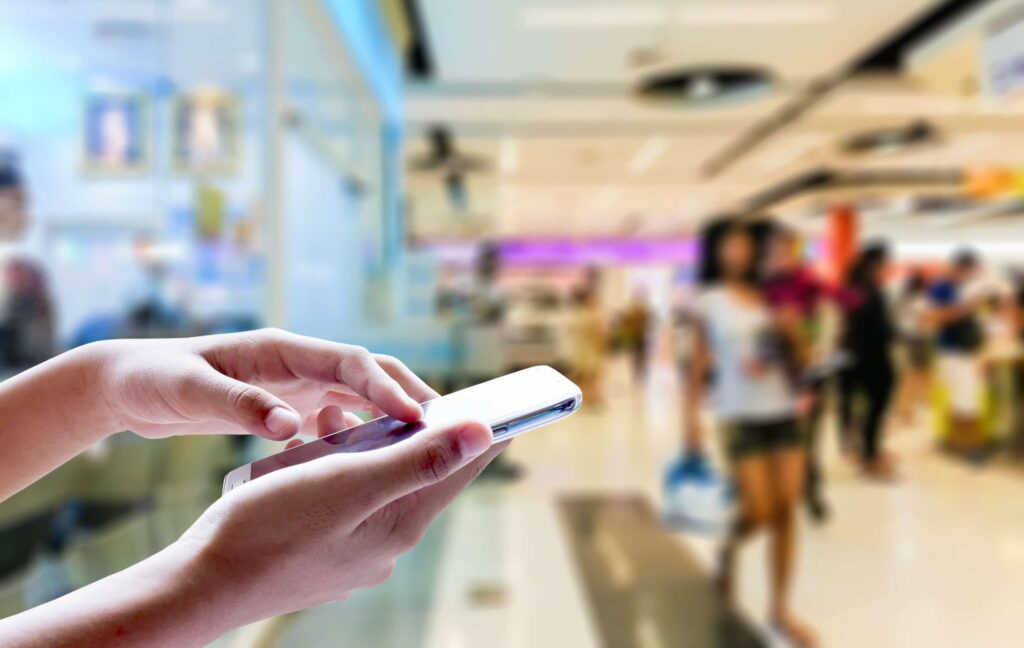The majority of shoppers (82%) make their purchasing decisions while in-store, typically after seeing, holding, and interacting with the product. Retailers need to find a way to reach customers at this pinnacle moment when they’re weighing their options. Store associates have been one of the only effective ways for retailers to influence the decision-making process in real-time, but technology—specifically proximity marketing—is swiftly moving in as the preferred way to personalize the shopping trip and deliver information, guidance, and tips during critical moments along the path to purchase.
The positive impact proximity marketing benefits have had on retailers has driven this marketing strategy to the forefront of the industry. Whether you use beacons or GPS technology, reaching shoppers on mobile devices with relevant, real-time messaging will be a boon to your retail business in 2021.
Here are some core proximity marketing benefits you can expect to see if you decide to implement the strategy:
1. Influence Customers On-the-Go.
Proximity marketing falls under the omnichannel strategy of retail marketing, which aims to reach and influence consumers through the various channels in which they shop. Omnichannel retail eCommerce in 2020 has had a significant impact on in-store purchases. Whether you think of it as delivering a consistent experience across channels or establishing a presence where people are buying, omnichannel is not so much a “trend” as it is the most effective way to conduct business.
Mobile has become one of the most important components of omnichannel shopping. People spend nearly 4 hours per day on mobile devices, and 82% of shoppers consult their smartphones before making an in-store purchase.
Proximity marketing messages can be delivered through a complimentary app, or can simply target shoppers passing by the store (so long as they have Bluetooth enabled). The average click-through rate of proximity marketing messages can reach 80%, which is significantly higher than the 0.119% click-through rate of Facebook ad CTRs and 1-3% email open rate.
2. Access Touchpoint Opportunities.
A touchpoint refers to any given time a customer comes into contact with your brand. Storefronts, showrooms, employees, checkouts, email communications, TV ads, billboards, in-store displays, online ads, coupons, mobile texts, and app interactions can all be considered touchpoints.
The average sale requires about eight touchpoints, though it could be more or less depending on your niche. Every opportunity you have to leave a favorable impression helps bring a shopper one step closer to a purchase, whether it’s the first or it’s been a while since the last.
With proximity marketing, beacon technology can send relevant messaging to customers at the most opportune times, creating multiple touchpoints in one consumer journey. For instance, a shopper may be greeted upon entering a retail store with personalized recommendations. Later on, they may receive notice of a nearby deal on a wish-listed item, and then be offered a reward for interacting with or purchasing the product.
Together, these messages can positively influence the consumers’ path to purchase, encouraging them to select your product over the competition.
3. Increase Engagement.
Sustaining engagement is necessary to keep customers loyal. Since it’s 5x to 25x cheaper to retain an existing customer than it is to solicit a new one, investing in engagement is critical.
Engagement-related activities keep shoppers informed of new arrivals, promotions, and product recommendations while providing retailers with valuable feedback. Engagement is necessary to improve marketing campaign return on investment (ROI), keep customers happy, and grow referrals.
Proximity marketing is one of the most effective ways to increase engagement. In 2020, 48% of retailers said they would use location data to engage customers. Proximity marketing provides a means to target customers in real-time at the point of purchase. Beacons can drive relevant promotions, answer questions, and provide additional incentives to “buy now.”
4. Drive Immediate Conversions.
Today’s shoppers seek a “hyper-relevant” experience, which is when a retailer knows who the customer is and what the customer is trying to achieve in a real-time shopping context. Targeted promotions, in-store analytics, and proximity marketing solutions help deliver hyper-relevance to consumers.
These tactics will improve a brand’s or retailer’s perceived value, and will also prompt an uptick in sales conversions. Hyper-relevant location-based notifications increase sales by an average of 24% when delivered directly near the products or services promoted.
To see proximity marketing in action, you can look to Purina’s holiday campaign with Shopkick. When Purina partnered with the mobile shopping rewards app, their goals were to increase awareness and use in-store messaging to drive trial and consideration of their products at Target during the busy holiday season.
Shopkick first promoted in-app content to shoppers at-home to drive awareness and interest. Shopkick then leveraged proximity messaging to drive shoppers in-store and greet them once they entered the store, keeping Purina top-of-mind. Finally, to drive product engagement and incremental conversion, Shopkick used reward incentives to encourage shoppers to seek out the product at-shelf.
Of all sales driven, 85% were incremental, and 36% of shoppers were previously unfamiliar with the product before introduction through the Shopkick app. Forty-seven percent of shoppers also reported future purchase intent.
Are You Ready to Reap Proximity Marketing’s Benefits?
Proximity marketing’s prominence is growing among retailers who are looking to impress consumers with an elevated level of personalization and timeliness. With competition increasing by the minute, it is imperative for retailers to find ways to differentiate themselves in order to gain market share. Proximity marketing is retailers’ key to differentiation in 2021.
Want to learn more about how proximity marketing benefits retailers? Read our success stories and contact Shopkick to learn how to become a partner and integrate proximity marketing into your 2021 strategy.





